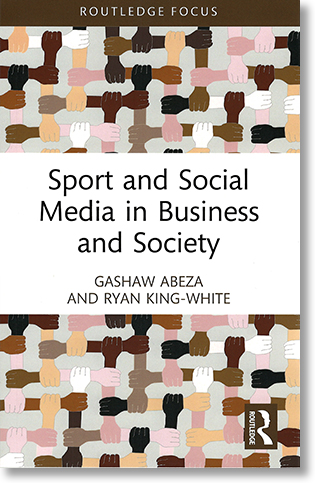Viktor Magnusson
School of Business and Economics, Linnaeus University

Sport and Social Media in Business and Society
119 pages, paperback
Abingdon, Oxon: Routledge 2025 (Routledge Focus on Sport, Culture and Society)
ISBN 978-1-032-41504-8
Social media has, in a very short time, become a natural part of everyday life – an arena where identity, community, and entertainment intersect. For the world of sports, platforms like Instagram, TikTok, and X (formerly Twitter) have fundamentally changed the playing field: fans gain direct access to their idols, clubs build global brands, and sponsors find new ways to reach audiences. Digital presence not only shapes the relationship between stakeholders and audiences, but also influences how sport is consumed, experienced, and valued. Yet, alongside the many opportunities come challenges related to credibility, integrity, commercial interests, and controversies that shape the future of sport.
Sport and Social Media in Business and Society is a concise and practice-oriented book of around 120 pages that explores the significance of social media for the sports industry. Chapter 1 covers the history and development of social media. Chapter 2 addresses social media in a sports context, discussing how it can be used within sports organizations. Chapter 3 examines how social media can be managed and used strategically. Chapter 4 describes social media in relation to traditional media. Chapter 5 addresses legal and ethical aspects, and in the final chapter, Chapter 6, the authors discuss the social issues brought on by social media. The book is based on contemporary research and includes interesting case studies that exemplify the topics discussed in each chapter.
I am especially thinking of the two concluding chapters, which address important issues such as legal, ethical, and social aspects – topics that we do not always reflect upon in everyday practice.
I work at a Swedish university and teach, among other things, communication on social media. The range of textbooks in this field has increased significantly in recent years as research has caught up. Most textbooks in the area focus on how companies and organizations can use social media to achieve their goals, often concentrating on strategic planning of communication. Here, Sport and Social Media in Business and Society stands out compared to much of the literature available on the market. If you are looking for a book that will improve your strategic communication skills on social media, this is not the book for you. Instead, it deals with the significance of social media for the sports industry, highlighting both the positive and negative aspects. In this way, the book is different from much of the other literature I have come across. I should add, of course, that I have not read everything available, but quite a bit.
Even if you have worked with social media for some time, or have been active as a user yourself, I believe this book still has something to offer. I am especially thinking of the two concluding chapters, which address important issues such as legal, ethical, and social aspects – topics that we do not always reflect upon in everyday practice. Social media, as most people know, has a darker side, such as threats and hate speech. The book discusses and problematizes this effectively, showing how concepts like freedom of speech often are misinterpreted. In reality, freedom of speech does not mean you can say whatever you want, yet this is often seen as “accepted” on social media, which instead fosters hostility and hate speech. Another strength of the book is the discussion in Chapter 6 on social challenges and values in society, and their impact on conversations in social media. This is a very interesting chapter that deals with topics such as social class, ethnicity, gender/sexuality, and how these influence online discussions and the sport industry in general.

The book also has a clear theoretical foundation, with content based on up-to-date research in the field. The authors have done a thorough job of reading up on current research on the topics covered, which makes the content credible. A weakness of much of the older social media literature is that it has not always been based on the latest research but rather on successful campaigns that were generalized. This “problem” is not present in Sport and Social Media in Business and Society.
I would say that Abeza’s and King-White’s book is an important addition to the literature in this field and is suitable both for practitioners who work with social media in their daily routines and for students, for example, at university level. If you are looking for a book that tells you how to do things on social media, this is not the book for you. But if you want a deeper understanding of how social media works and what can happen there, then this is the right book. Even though it is written by American authors and most of the cases are based in North America, it also works well for understanding social media in a Swedish or Nordic context. In this regard, we are not particularly different from the rest of the world.
With only 120 pages, the book naturally cannot cover everything in depth, and at times the content feels somewhat superficial. Certain parts deal with complex themes (such as social and ethical discussions), and here the reasoning sometimes feels underdeveloped. At the same time, I see the scope as one of the book’s strengths. It does not feel burdensome to read, and although the content is sometimes brief, it is highly relevant.
Copyright © Viktor Magnusson 2025






